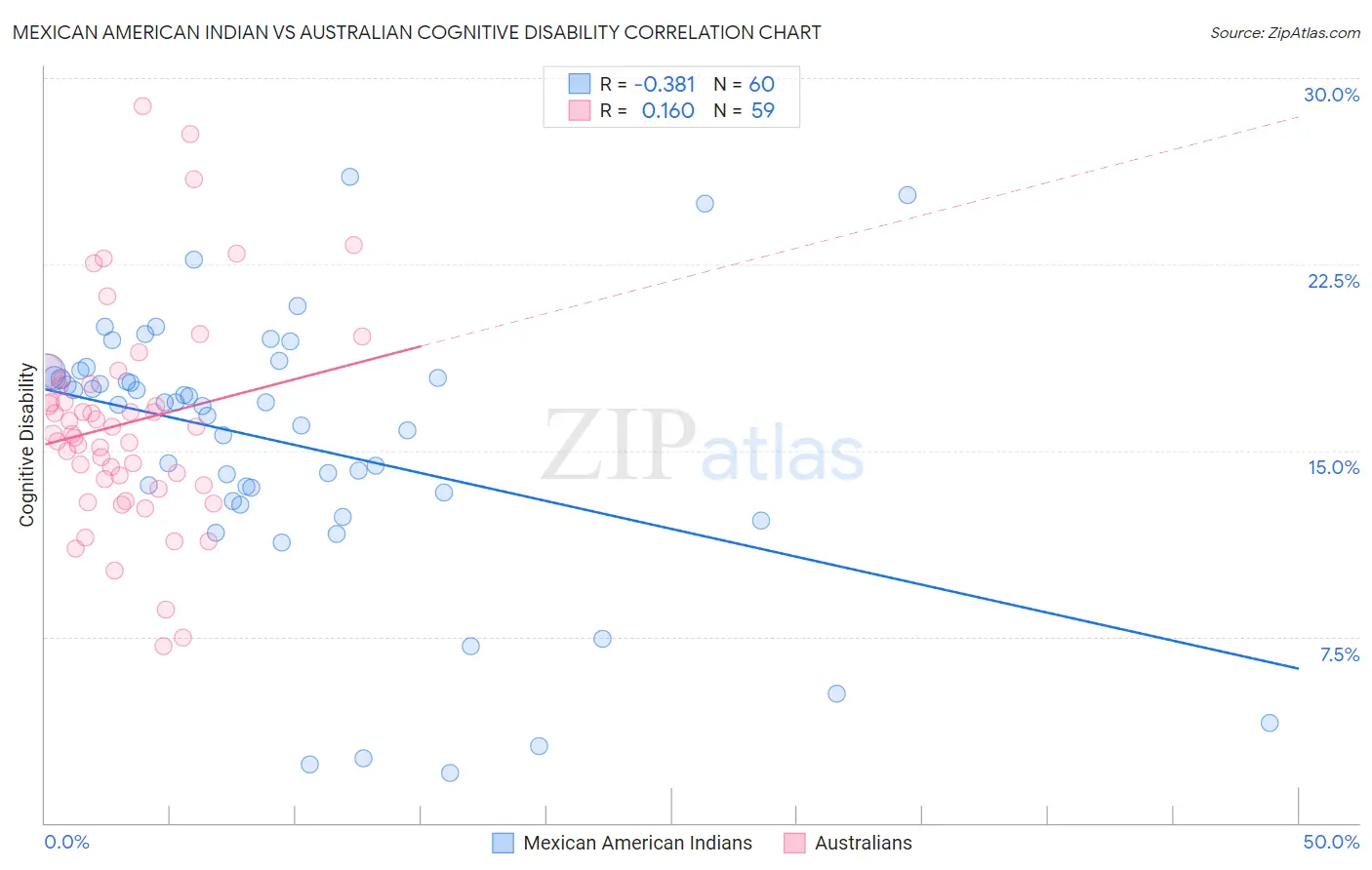Mexican American Indian vs Australian Cognitive Disability
COMPARE
Mexican American Indian
Australian
Cognitive Disability
Cognitive Disability Comparison
Mexican American Indians
Australians
17.9%
COGNITIVE DISABILITY
0.6/ 100
METRIC RATING
257th/ 347
METRIC RANK
17.2%
COGNITIVE DISABILITY
72.4/ 100
METRIC RATING
160th/ 347
METRIC RANK
Mexican American Indian vs Australian Cognitive Disability Correlation Chart
The statistical analysis conducted on geographies consisting of 317,571,331 people shows a mild negative correlation between the proportion of Mexican American Indians and percentage of population with cognitive disability in the United States with a correlation coefficient (R) of -0.381 and weighted average of 17.9%. Similarly, the statistical analysis conducted on geographies consisting of 224,142,484 people shows a poor positive correlation between the proportion of Australians and percentage of population with cognitive disability in the United States with a correlation coefficient (R) of 0.160 and weighted average of 17.2%, a difference of 4.4%.

Cognitive Disability Correlation Summary
| Measurement | Mexican American Indian | Australian |
| Minimum | 2.0% | 7.1% |
| Maximum | 26.0% | 28.9% |
| Range | 24.0% | 21.7% |
| Mean | 15.2% | 16.1% |
| Median | 16.9% | 15.7% |
| Interquartile 25% (IQ1) | 13.1% | 13.6% |
| Interquartile 75% (IQ3) | 18.0% | 17.7% |
| Interquartile Range (IQR) | 4.9% | 4.1% |
| Standard Deviation (Sample) | 5.4% | 4.3% |
| Standard Deviation (Population) | 5.4% | 4.3% |
Similar Demographics by Cognitive Disability
Demographics Similar to Mexican American Indians by Cognitive Disability
In terms of cognitive disability, the demographic groups most similar to Mexican American Indians are Immigrants from Armenia (17.9%, a difference of 0.010%), Bahamian (17.9%, a difference of 0.040%), Hopi (17.9%, a difference of 0.050%), Hispanic or Latino (17.9%, a difference of 0.050%), and Immigrants from the Azores (17.9%, a difference of 0.050%).
| Demographics | Rating | Rank | Cognitive Disability |
| Immigrants | Ethiopia | 0.7 /100 | #250 | Tragic 17.9% |
| Malaysians | 0.6 /100 | #251 | Tragic 17.9% |
| Immigrants | Grenada | 0.6 /100 | #252 | Tragic 17.9% |
| Hopi | 0.6 /100 | #253 | Tragic 17.9% |
| Hispanics or Latinos | 0.6 /100 | #254 | Tragic 17.9% |
| Immigrants | Azores | 0.6 /100 | #255 | Tragic 17.9% |
| Bahamians | 0.6 /100 | #256 | Tragic 17.9% |
| Mexican American Indians | 0.6 /100 | #257 | Tragic 17.9% |
| Immigrants | Armenia | 0.6 /100 | #258 | Tragic 17.9% |
| Ethiopians | 0.5 /100 | #259 | Tragic 17.9% |
| Immigrants | Belize | 0.5 /100 | #260 | Tragic 17.9% |
| Guamanians/Chamorros | 0.5 /100 | #261 | Tragic 17.9% |
| Sierra Leoneans | 0.4 /100 | #262 | Tragic 17.9% |
| Immigrants | Barbados | 0.4 /100 | #263 | Tragic 17.9% |
| Menominee | 0.4 /100 | #264 | Tragic 18.0% |
Demographics Similar to Australians by Cognitive Disability
In terms of cognitive disability, the demographic groups most similar to Australians are American (17.2%, a difference of 0.010%), Immigrants from Latvia (17.2%, a difference of 0.030%), Yugoslavian (17.2%, a difference of 0.030%), Immigrants from Switzerland (17.2%, a difference of 0.030%), and Celtic (17.1%, a difference of 0.060%).
| Demographics | Rating | Rank | Cognitive Disability |
| Immigrants | Kazakhstan | 80.5 /100 | #153 | Excellent 17.1% |
| Immigrants | Malaysia | 79.3 /100 | #154 | Good 17.1% |
| Brazilians | 78.9 /100 | #155 | Good 17.1% |
| Sri Lankans | 78.9 /100 | #156 | Good 17.1% |
| Immigrants | Australia | 76.0 /100 | #157 | Good 17.1% |
| Celtics | 74.1 /100 | #158 | Good 17.1% |
| Immigrants | Latvia | 73.2 /100 | #159 | Good 17.2% |
| Australians | 72.4 /100 | #160 | Good 17.2% |
| Americans | 72.2 /100 | #161 | Good 17.2% |
| Yugoslavians | 71.6 /100 | #162 | Good 17.2% |
| Immigrants | Switzerland | 71.5 /100 | #163 | Good 17.2% |
| Armenians | 70.1 /100 | #164 | Good 17.2% |
| Immigrants | Albania | 64.9 /100 | #165 | Good 17.2% |
| Immigrants | Ecuador | 64.4 /100 | #166 | Good 17.2% |
| Immigrants | Syria | 63.5 /100 | #167 | Good 17.2% |